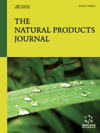- Home
- A-Z Publications
- Natural Products Journal, The
- Previous Issues
- Volume 13, Issue 4, 2023
Natural Products Journal, The - Volume 13, Issue 4, 2023
Volume 13, Issue 4, 2023
-
-
The Important Nutritional and Wonderful Health Benefits of Cashew (Anacardium occidentale L.)
More LessAuthors: Mohamad H. Shahrajabian and Wenli SunTraditional medicines are considered as both food items and medicine, which have been used for thousands of years. They contain aerial and underground parts of plants as active ingredients, and they also contain a variety of pharmacologically active plant constituents. The aim of this study was to summarize and highlight the most important traditional and modern health benefits of cashew nuts. The literature search Read More
-
-
-
Phytochemistry and Pharmacology of Indian Traditional Plant Hyssop (Hyssopus officinalis L.): A Review
More LessAuthors: Vanktesh Kumar, Navjot Kaur, Arvinder Kaur and Pankaj WadhwaHyssopus officinalis is a traditional medicinal plant that belongs to the family Lamiaceae, which has been used for centuries for various purposes like carminative, expectorant, and cough reliever. It has been used for the treatment of numerous diseases in patients such as ulcers, asthma, jaundice, leprosy, dropsy, bronchitis, COPD, diabetes, AIDS, bacterial and fungal infections as an herbal remedy due to its fewer side eff Read More
-
-
-
Phytochemistry and Medicinal Importance of Herb Mimosa pudica: A Review
More LessAuthors: Venzil W. Fernandes, Santosh L. Gaonkar and Nitinkumar S. ShettyBackground: Mimosa pudica is a tropical weed that belongs to the legume family and is native to South America. This plant is also found in different regions of India, such as Andhra Pradesh, Telangana, Karnataka, Kerala, Orissa, and Tamil Nadu. It is a known plant that can show thigmonasty. The plant possesses diverse biological properties, including antimicrobial, antidiabetic, anticonvulsant, antivenom, anti-inflammatory, antitu Read More
-
-
-
Phytochemistry and Pharmacological Aspects of Apigenin: A Review
More LessAuthors: Hemlata Bhardawaj, Neeru Vasudeva and Sunil SharmaBackground: A bioactive flavone, apigenin, is plentifully present in common vegetables and fruits, including spinach, parsley, celery stalks, peas, black olives, olive oil, grapefruit, kumquat, honey etc. It is a low-toxic flavonoid. Flavonoids are currently considered an important component in a huge range of cosmetic, pharmacological, and medical formulations. According to epidemiological research, flavone-rich diets have bee Read More
-
-
-
Biological Importance of Flavonoid Bavachinin in the Medicine: Perspectives of Medicinal Importance, Pharmacological Activities and Analytical Techniques
More LessAuthors: Kanika Patel and Dinesh K. PatelBackgrounds: Phytochemicals are an important class of natural compounds present in vegetables, herbs, fruits, and seeds. Phytochemicals have been used in medicine for the treatment of human disorders in the form of drugs, medicine, and Nutraceuticals. Flavonoid class secondary metabolites were found to be present in medicinal plants and some food materials derived from plants. Flavonoid class phytochemicals Read More
-
-
-
Herbal Therapeutics as Potential Prophylaxis for SARS-CoV-2 Infection
More LessAuthors: Shipra Singhal, Abhishek Kumar, Deepti Katiyar and Vaishali M. PatilIntroduction: The global pandemic COVID-19 and its uncontrolled spread and lack of effective therapeutics demand to investigate the herbal resources in search of novel, safe and potent therapeutics. Herbal medicines have proven the advantage of multi-target potential and thus can be investigated for virus-host interaction protein and viral protein targets. Objectives: The manuscript aims to provide an outcome-based a Read More
-
-
-
Targeting Breast Cancer in Diabetic Mice Using a Combination of Thymoquinone and Metformin
More LessAuthors: Naeimah S. Sulayman Aboulqassim and Wamidh H. TalibObjective: The aim of our study was to assess thymoquinone (TQ) as a combination therapy with metformin (MT) against breast cancer in diabetic tumor-bearing mice. Methods: The antiproliferative activities of TQ and MET and their combination were tested against three breast cancer cell lines (EMT6/P, T47D, MDA-MB-231) using an MTT assay. We used the isobolographic method to calculate the combination index (CI). Balb Read More
-
Most Read This Month
Article
content/journals/npj
Journal
10
5
false
en


